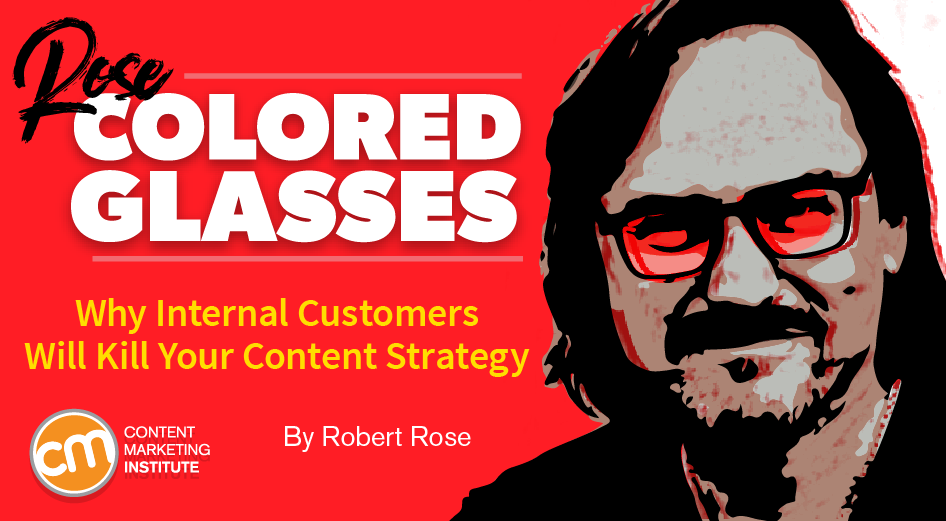MARKETING
Why Internal Customers Will Kill Your Content Strategy

I see one mistake derailing great content marketing strategy again and again in my consulting practice.
Businesses set up their content teams as internal agencies to serve internal ‘customers’ in other departments.
Why is that a problem?
Sometimes this approach incorporates some priority planning. Usually, this planning involves internal “stakeholders” who decide the significant themes or the priority for tackling content requests.
But just as often, no planning or prioritization occurs. The content calendar is a to-do list based on ad hoc requests from various other teams. And the content team becomes Kinkos, racing to churn out assets as orders pour in.
Eventually, the content team fails to live up to expectations, the content is imbalanced, and the creators and producers burn out.
So, when the content strategy needs a reboot – and it will – how do you align the new content approach with internal customers’ expectations?
First, stop thinking of them (or letting anyone else think of them) as your customers.
To reboot your #ContentStrategy, stop thinking of internal teams as customers, says @Robert_Rose via @CMIContent. Click To Tweet
Stakeholders are investors, not customers
In marketing, we throw around the term stakeholders to refer to people affected directly by your efforts. That list is long – content and marketing touch almost every other function (business leaders, IT, sales, communications, public relations, product, and external groups like partners and investors).
But a funny thing happens when I ask the content team if they consider themselves to be stakeholders in sales or comms. The content team leaders laugh softly and say, “Oh no, they’re our customers.”
That’s not ideal. I once worked with a B2B company where the content marketing team existed to respond to the product marketing team’s requests for “thought leadership” to accompany new product launches. But the product marketing team viewed thought leadership as lightly veiled customer success stories or fact-filled technical schematics of how their product worked.
How did this approach work? Not well. The product marketing team loved the content. But the potential real customers didn’t.
Content teams achieve consistent success only when they’re elevated to stakeholder status. In other words, content strategy and content marketing teams only succeed when they lead strategic content efforts alongside their peers instead of serving as on-demand content production resources.
#ContentMarketing teams succeed only when they lead strategic content programs instead of producing on demand, says @Robert_Rose via @CMIContent. Click To Tweet
Marketing and content teams are skilled practitioners of a professional discipline. They’re not there to “service” the stakeholder groups but to learn, align, and work with them. Those groups are invested in content’s success because it means that, as a result, they succeed.
Internal stakeholders (also like investors) can serve as independent sources of information. They can offer details to inform priorities and insight to improve processes, and cooperation to attract new investment. Or they can also sabotage every effort you make and profit from your misery.
So, interviewing and getting stakeholder alignment is critical when implementing a new approach to content strategy or content marketing.
Here are three steps you can take to treat stakeholders as investors in your process and get alignment on your proposed approaches.
1. Segment your investor stakeholders
One of the keys to getting alignment is to identify the different types of stakeholders that will be critical to ensuring traction for your new content approach:
Influencers. Get input from and align with stakeholders who hold an influential position or control your budget. Influencer stakeholders may not have much to do with the content or even care much about it. But unless you win them over, your cause is sunk.
Champions. These cheerleaders will stand behind you, support your efforts, and be early adopters of new ways of doing things. Identify these quickly (some might also be part of the influencer group).
Detractors. You’ll potentially encounter two categories of these naysayers. One set includes people who oppose change because they see nothing in it for them. The other set consists of those who are apathetic. When you ask about their participation or agreement, they say something like this: “Well, it’s not no.” They sit back and see how the politics play out before helping or actively detracting.
Decision makers. Decision makers are just what they sound like – they’re the people who make decisions that help or prevent your efforts from turning into success.
Participants. These individuals have an active stake in your approach and will be responsible for making it work. They have functional expertise in one of the adjacent areas your content strategy will affect.
As you might expect, people may share multiple attributes. You may have champion influencers or detractor participants. The key is to not view them in terms of how to get their nod of approval or “buy-in” to the content team process. Instead, see them as investors in an additive piece of your shared process.
2. Design discussions, not interviews
Once you’ve identified who’s who, it’s time to meet with them to gather information and gain alignment.
Remember, every objection to change is an explicitly stated fear of uncertainty.
A common mistake in stakeholder alignment is to hear objections from detractors as “customer” requirements that you must meet to pass their approval. But the objections may be simple concerns about their own challenges that, once addressed, disappear.
Another mistake is to consider approvals from champions as full-throated agreements. The approvals might be lukewarm – like the “not no” detractor response.
Stakeholder interviews aren’t focus groups that show you what your customers need. If you treat them that way, don’t be surprised when those same stakeholders don’t care about all the features you added to your service – even if they were the ones to suggest them.
So don’t design your discussions solely around what information or requirements you need to gather to complete your business case or plan. Instead, use the chance to uncover what each stakeholder needs to become an investor in your mutually beneficial approach.
With that understanding, you’ll gain the ability to lead them, leverage them, or learn from their needs.
3. It’s a process, not a project
The investor relations part of your job begins once you get your initial buy-in and continues throughout your tenure in whatever role you have.
You’ll have multiple discussions with stakeholders before you’ve built your case, once your case is approved, after implementation has begun, and again as you manage your overall process.
I remember one successful, award-winning content marketer hearing her project invoked as a best-in-class case study for the zillionth time at Content Marketing World and saying to me: “I wish somebody would tell my stakeholders that. I’m still fighting for budget, relevance, and buy-in every single day.”
HANDPICKED RELATED CONTENT:
All customers are stakeholders, but not all stakeholders are customers
Now, of course, customers are the one missing group in my list of stakeholders. And they’re the critical stakeholder in any marketing content strategy.
But they’re a different class of stakeholder. Don’t conflate them with internal stakeholders.
Don’t conflate internal stakeholders with customers, says @Robert_Rose via @CMIContent. Click To Tweet
The strategist and author Eli Goldratt once wrote, “Tell me how you measure me, and I will tell you how I will behave. If you measure me in an illogical way, don’t complain about illogical behavior.”
Seeing content teams as internal vendors built only to delight internal customers sets the wrong objective. It encourages the idea that all internal stakeholders are the same as customers – and that success means meeting all their needs.
But while all customers are stakeholders, not all stakeholders are customers. Most are better treated as investors – a key constituency that benefits from a co-created approach to content as a strategy.
Don’t serve them. Instead, lead them. That’s how you’ll make their investment of time, money, effort, and information more and more valuable.
It’s your story. Tell it well.
Get Robert’s take on content marketing industry news in just five minutes:
Watch previous episodes or read the lightly edited transcripts.
Cover image by Joseph Kalinowski/Content Marketing Institute



















You must be logged in to post a comment Login